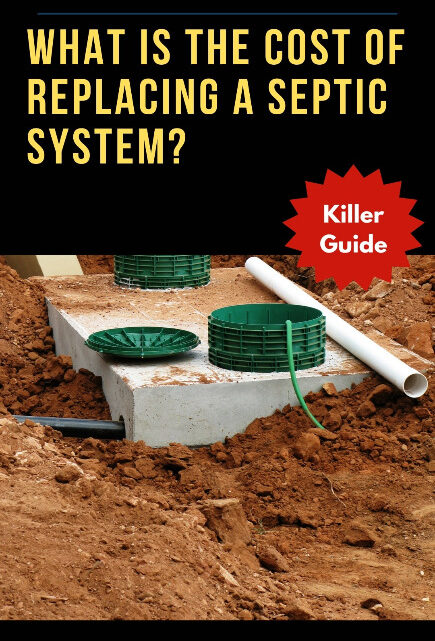Do you need to replace your septic system in Massachusetts?
An essential but rarely discussed element of home ownership has captured rising financial focus: the septic system installation. The economic landscape of contemporary society and fluctuating material costs call for a comprehensive understanding of this hidden expense.
Knowing your potential investment can help save you from unexpected budget strains and tomorrow’s unforeseen headaches.
Dive into this preemptive tour of the average price, cost variables, and best estimates regarding septic system installations in our unpredictable world.
The cost of a Massachusetts septic system installation can vary depending on location, soil conditions, size, and the type of system chosen.
On average, septic system installations can cost around $20,000. However, specialized or complex engineered systems may cost upwards of $50,000. It’s essential to consult with septic system professionals in your area for more accurate estimates based on your specific needs.
As a realtor, I’ve seen a significant range in septic system installation pricing for the past thirty-eight years.
Getting at least three bids when you need a replacement will be worth your time. Believe it or not, I have seen pricing swings from $ 8,000 to $10,000 in the bids.
That is quite a difference! The system in the ground will look and function the same. Don’t waste your money on a Massachusetts septic installer who will gauge the price.
Many homeowners don’t know how to care for their septic systems. It is a significant reason for failure.
Overview of Septic System Installation in Massachusetts
Septic system installation is crucial for homes not connected to a municipal sewer system. It involves constructing and installing an underground wastewater treatment system on the property.
The purpose of a septic system is to safely and efficiently treat and dispose of household wastewater, including sewage.
A septic system provides an alternative method of managing wastewater when a home is not connected to a public sewer system. The installation process starts with a site evaluation, where factors such as soil conditions, property size, and regulations are considered.
Then, a suitable design is created based on the property’s specific needs.
Once the design is finalized with a land engineer, it must be approved by the local Board of Health.
The installation begins with excavation work to create a space for the septic tank and other components. It’s essential to ensure proper placement and alignment of all elements during this stage to ensure optimal functionality and longevity.
Next comes the installation of the septic tank. It serves as the primary holding area for solid waste and allows for separating solids from liquids. Pipes and leaching or drain fields are also installed to facilitate the distribution and treatment of wastewater in the surrounding soil.
It’s worth noting that professionals should always perform septic system installation due to its complexity. If not done correctly, DIY attempts can lead to costly mistakes and potential health hazards.
Interesting Statistics on Pricing
Now that we have an overview of septic system installation let’s examine the components and functions of these systems.
- Based on nationwide surveys, the average cost for a standard septic tank installation in the United States is approximately $6,300. However, remember that the prices of the Massachusetts septic system are much higher due to soil conditions and regulations.
- Specialized or complex engineered systems can cost as much as $30,000 or more depending on associated factors such as material and size of tank.
- Labor constitutes a substantial portion of overall costs, estimated between 50% to 70% of the total project price.
Components and Functions of Massachusetts Septic Systems
Septic systems consist of several vital parts that work together to manage the flow and treatment of wastewater from a home. Understanding these components can help homeowners comprehend how their septic systems operate.
The main components of a septic system include:
- Septic tank: This tank holds solid waste while allowing liquids to separate and move to the next stage of treatment. It is an essential element of a septic system and must be appropriately sized according to the household’s wastewater output. Knowing where your septic tank is located is vital for regular maintenance.
- Distribution Box: Located after the septic tank, the distribution box evenly distributes the treated effluent into multiple leaching or drain lines, ensuring proper distribution across the drain field area.
- Leaching or Drain Field: This leach field is a network of perforated pipes buried in trenches filled with gravel or other suitable materials. Effluent from the septic tank enters these pipes and undergoes further treatment as it gradually percolates through the soil.
- Soil: Natural soil is a biological filter during the final wastewater treatment. It removes harmful bacteria and pathogens while absorbing and filtering out various contaminants.
By understanding each component’s purpose and role, homeowners can better appreciate how their septic systems effectively treat and manage wastewater on their properties.
Interesting Facts on a Septic Tank System
1. The cost of a septic system depends on various factors, including the size of the property and the soil conditions.
2. A basic septic system installation in Massachusetts can range from $10,000 to $25,000.
3. More complex septic systems, such as ones with advanced treatment options or larger holding capacities, can cost $25,000 or more.
4. The cost may also include fees for permits and inspections.
5. Maintenance and pumping costs should also be factored in, typically ranging from $200 to $600 every 3-5 years.
6. The property’s location can impact the cost due to transportation and accessibility challenges.
7. In some cases, obstacles like trees or structures may need to be removed or relocated, adding to the overall cost.
8. Depending on local regulations, additional components such as alarms or filters may be required, increasing the cost further.
9. Retrofitting an existing property with a septic system can be more expensive than installing one during construction.
10. It’s always recommended to obtain several quotes from reputable Massachusetts septic system installers before deciding on cost.
11. An engineer will be needed to create a land survey for the new septic system design. They will perform a perc test and evaluate groundwater levels as part of the process. Land survey costs can vary depending on the project requirements.
Cost Analysis: Factors Affecting the Price of Septic System Installation in Massachusetts
Massachusetts septic system installation costs can vary significantly depending on various factors. Conducting a cost analysis to understand what influences these prices and make informed decisions is essential.
Some key factors affecting the price of septic system installation include:
- Type of system: The type of septic system chosen will play a significant role in determining the cost. Conventional systems tend to be more affordable, while complex engineered systems can be much more expensive. The number of bedrooms will also factor into the pricing.
- Tank material and size: The material and size of the septic tank also contribute to the overall cost. Tanks can range from 500 to 1,500 gallons, with larger tanks being more costly.
- Local regulations: Compliance with local laws can impact the installation process and associated costs. It’s important to consider any permits or inspections required by local authorities.
- Site conditions: The site’s characteristics, such as where the septic system will be installed, can also affect the cost. Factors such as soil conditions, terrain, and accessibility may require additional excavation or specialized equipment, leading to increased expenses.
It’s important to remember that these factors interact, making each installation unique in terms of cost.
Consulting with professionals and obtaining multiple quotes will help you better understand how these factors apply to your situation. Various factors influence the price of Massachusetts septic system installation.
These include the type of system chosen, the material and size of the septic tank, and compliance with local regulations. The characteristics of the site where the installation will occur are also considered.
Understanding how these factors interact and consulting with professionals will help you make informed decisions regarding the cost of septic system installation.
Role of Soil Conditions and System Type
Soil conditions are crucial in determining the feasibility and cost of installing a septic system. Different soil types have varying permeability levels, affecting how well wastewater can filter through them.
Some soils retain water more efficiently, while others drain quickly.
For instance, sandy or gravelly soils have better drainage capabilities than clayey or compacted soils. Alternative or specialized systems may be required in areas with poor soil permeability, increasing the overall installation costs.
To exemplify the impact of soil conditions on system selection and cost, consider the following:
| Soil Type | System type |
|---|---|
| Sandy or gravelly soils | Conventional or gravity-fed system |
| Clayey or compacted soils | Engineered or alternative system |
Understanding the soil conditions is crucial because selecting an appropriate septic system ensures efficient wastewater treatment and minimizes potential issues in the future. Installing a septic system without considering soil conditions can result in operational problems, such as drainage failures and costly repairs.
Therefore, conducting a percolation test (also known as a soil test) is imperative to assess the soil’s permeability. This test determines how quickly water can pass through the ground. It also helps guide the selection process for the most suitable septic system.
A professional contractor can assist in conducting these tests and provide recommendations based on the results.
By considering soil conditions and system type, homeowners can make informed decisions that optimize performance, minimize maintenance costs, and ensure long-term functionality.
Ongoing Maintenance and Operating Costs
When it comes to the cost of septic system installation, it’s essential to consider not only the upfront expenses but also the ongoing maintenance and operating costs.
Proper maintenance is crucial in ensuring the long-term functionality of your septic system and can help prevent costly repairs or replacements down the line.
Regular maintenance tasks include inspecting and pumping the septic tank every two to three years, cleaning the filters periodically, and being mindful of what goes down the drains to avoid clogs or damage to the system.
These maintenance activities may incur additional costs but are essential for keeping your septic system in good working condition.
To give you a rough idea of the average costs involved, septic tank pumping for smaller tanks can range from $100 to $200, while larger 2,000-gallon tanks can cost up to $800. On average, you can expect to pay around $0.30 per gallon pumped.
It’s important to note that these costs can vary depending on location, tank size, usage, and pumping frequency. Some areas may have prices ranging from $200 to $350, while others may range from $350 to $800.
Importance of Regular Inspections and Pumping
Regular inspections and pumping are crucial for maintaining the health and functionality of your septic system. Over time, neglecting these activities can lead to various problems.
Think of regular inspections as preventive check-ups for your septic system. Having a professional inspect your system every three years can identify potential issues before they escalate into major problems. This can save you from costly repairs or even complete system failures.
When replacement becomes necessary, it could disrupt your household routines and require significant financial investments.
“Regular inspections have helped me catch minor issues with my septic system before they turned into major headaches. It’s a small price to pay for the peace of mind it brings.” – Bill Gassett, Realtor and homeowner.
Moreover, pumping the septic tank is essential to prevent excessive buildup of solids. Over time, solid waste accumulates in the tank and can clog the drain field or cause sewage backups in your home.
By pumping the tank every two to three years, you ensure the solids are appropriately removed from the system, reduce the blockage risk, and maintain efficiency.
Investing in regular inspections and scheduling timely pumpings for your septic system increases its longevity. Proper maintenance minimizes the chances of costly repairs or replacements.
The peace of mind and financial savings make these maintenance activities well worth their cost in the long run.
Cost Considerations for Septic System Repairs and Replacements in Massachusetts
Several factors affect the cost of septic system repairs or replacements. It’s essential to consider these aspects as they can significantly impact the overall expenses associated with the project.
The first consideration is the nature and extent of the repair or replacement needed. Minor repairs, such as fixing a broken pipe or replacing a damaged component, may be inexpensive. However, costs can escalate considerably if the septic tank needs to be repaired or replaced.
Size and material are important considerations when determining the cost of a new septic tank installation.
Additionally, the chosen type of septic system can affect costs. Various styles are available, such as conventional systems, aerobic treatment units (ATUs), or mound systems, each with its own price range. Factors such as soil conditions and local regulations may also influence the choice of design and associated costs.
Location is vital in determining the cost of septic system repairs or replacements. The accessibility of your property and proximity to necessary resources like water sources, electrical connections, and local sewer lines can impact labor costs.
Challenging Soils Are a Significant Pricing Factor in Massachusetts
Additionally, the project can become more expensive if you live in an area with strict environmental regulations or challenging soil conditions requiring special permits or engineering solutions.
Let’s consider an example to understand cost considerations better. Sarah owns a house in a remote area with challenging soil conditions. She needs to replace her worn-out septic tank.
Due to limited accessibility, the need for specialized equipment, and expert labor to dig through rugged terrain, Sarah’s repair costs are higher than those of a house in an urban neighborhood with easy access to machinery.
Another crucial aspect to factor in is timing and scheduling. Weather conditions can significantly affect septic system installation timelines. Heavy rains or freezing temperatures can delay excavation and installation, ultimately impacting labor costs.
It’s important to consider potential weather-related setbacks when planning septic system repairs or replacements.
In conclusion, when estimating the cost of septic system repairs or replacements, it is essential to consider the nature and extent of the repairs, the type of system chosen, location-related considerations, and timing constraints.
These factors can affect expenses differently. They should be carefully evaluated to ensure accurate budgeting and planning for your septic system project.
If you have any questions on septic system expenses in Massachusetts, feel free to contact me.










No Comment